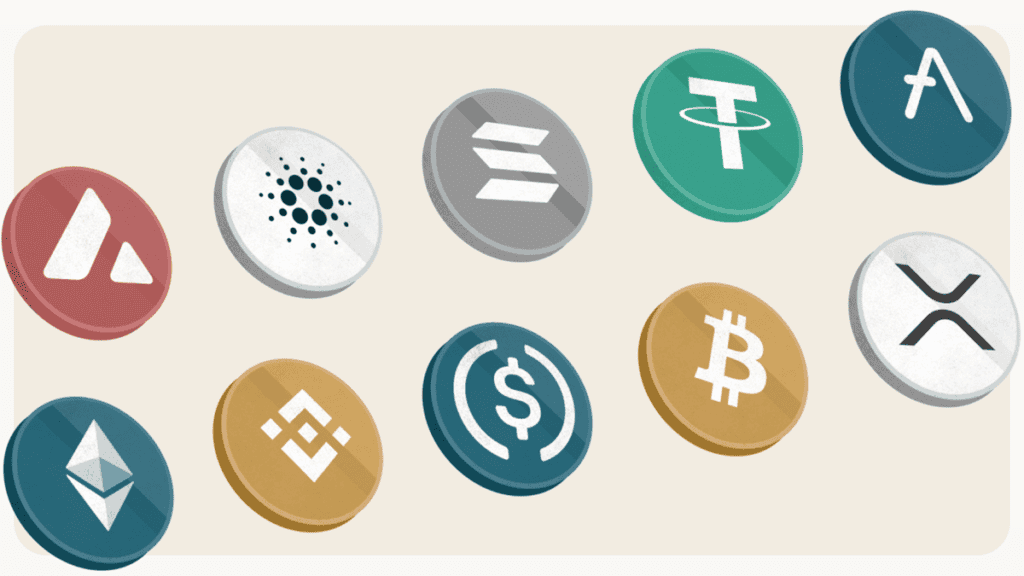Finding Crypto: A Guide to Cryptocurrency

Cryptocurrency, the digital money of the internet, has exploded in popularity. Some are like digital cash, while others provide access to specific features and ownership of real-world assets.
According to Investopedia, the types of cryptocurrency are;
Payment Cryptocurrencies: These are the digital workers of the crypto world, designed for everyday transactions like cash. They offer a decentralized and potentially faster transaction than the traditional one but also have high volatility and limited merchant adoption.
Altcoins: Also known as Alternative Coins, this broad term encompasses any cryptocurrency. While altcoins boast a more comprehensive range of functionalities and potentially faster transaction speeds, they carry a higher risk due to their relative and less established ecosystems.
Stablecoins: Unlike traditional cryptocurrencies, which are known for their price swings, stablecoins are known for their stability. While offering stability for each transaction, stablecoins may be centralized, relying on the underlying asset to maintain security.
Utility tokens: These digital coupons give access to specific features or services within a blockchain platform. While utility tokens offer benefits within their ecosystems, their value is tied to the platform’s success.
Security tokens are a new way to invest in traditional assets like stocks, bonds, or even real estate. They offer the potential for increase but are also strict regulations and may require compliance with security laws, making investing complex.
Privacy coins: Privacy coins offer prioritized anonymity by using advanced cryptography to obscure transaction details. However, privacy coins raise concerns about illegal activity and attract regulatory scrutiny. (The Investopedia Team, 2024).
Central bank digital currencies (CBDCs) are digital versions of traditional currencies issued and controlled by central banks. CBDCs have the potential to make transactions faster, cheaper, and more secure while giving central banks more significant control over the money supply. However, the main concerns are privacy concerns and centralization of control over money.
Cryptocurrency: Digital Currency Landscape
The world of cryptocurrency can be overwhelming, with an array of options and players. Therefore, this table serves as a roadmap, providing a clear overview of the significant cryptocurrencies and their associated companies.
| Cryptocurrency Type | Associated Companies | Description |
| Payment Cryptocurrencies | Bitcoin.org (Bitcoin) Litecoin Foundation (Litecoin) | Pioneering cryptocurrencies designed for everyday transactions, similar to cash. |
| Altcoins (Alternative Coins) | Ethereum Foundation (Ethereum) Ripple Labs (XRP) | A diverse category offering functionalities beyond just payments, including smart contracts and decentralized applications. |
| Stablecoins | Tether Limited (Tether) Centre Consortium (USD Coin) | Cryptocurrencies pegged to stable assets like the US dollar to minimize price volatility. |
| Utility Tokens | Binance (BNB) Brave Software (Basic Attention Token) | Tokens granting access to specific features or services within a particular blockchain platform. |
| Security Tokens | Harbor Polymath | Platforms facilitate the creation and issuance of security tokens, representing ownership of real-world assets. |
| Privacy Coins | Monero Research Lab (Monero) Zcash Foundation (Zcash) | Cryptocurrencies prioritize user privacy by obscuring transaction details through cryptography. |
| Central Bank Digital Currencies (CBDCs) | People’s Bank of China (exploring e-CNY) | Digital versions of fiat currencies issued and controlled by central banks (still under development). |
Decrypting Crypto: Understanding Different Coin Types
| Cryptocurrency Type | Strengths | Weaknesses |
Payment Cryptocurrencies | Decentralized and borderless transactions | High transaction fees Slow transaction processing times High volatility |
| Altcoins | Wide range of functionalities beyond payments (e.g., smart contracts, DeFi) Faster transaction speeds (compared to Bitcoin) | Higher risk due to novelty and less established ecosystems Potential for scams involving lesser-known altcoins |
| Stablecoins | Price stability minimizes volatility Suitable for transactions and a hedge against market fluctuations | May be centralized, relying on the underlying asset for stability Limited potential for significant growth |
| Utility Tokens | Facilitate interaction within specific blockchain platforms Offer benefits and discounts for users | Value heavily dependent on the success and adoption of the underlying platform Limited use cases outside their specific ecosystem |
| Security Tokens | New way to invest in traditional assets with the potential for increased liquidity Fractional ownership of assets previously indivisible | Highly regulated, requiring compliance with securities laws Complex investment with a learning curve |
| Privacy Coins | Increased user privacy and transaction anonymity | May raise concerns about illegal activity and attract regulatory scrutiny Lower adoption compared to other cryptocurrencies |
| Central Bank Digital Currencies (CBDCs) | Potential for faster, cheaper, and more secure transactions Increased control for central banks over the money supply | Privacy concerns and potential for centralized control over money Limited availability as they are still under development |
Crypto Impact: Effects of Diverse Digital Assets
Cryptocurrencies have exploded onto the scene, challenging traditional financial systems and sparking curiosity. But their impacts transcend mere transactions.
Financial Inclusion: Decentralized payment cryptocurrencies offer financial access to the unbanked, empowering outside the traditional systems.
Innovation Engine: The Altcoins fuel innovation with smart contracts and decentralized applications (dApps). Consequently, they unlock new possibilities in areas like supply chain management and data ownership.
Bridging the Gap: Stablecoins act as a bridge between traditional finance and the crypto world. They attract new users and facilitate everyday crypto transactions.
New Economic Models: Utility tokens reward user participants on specific blockchain platforms, increasing user engagement and the platform’s growth.
Democratizing Investments: Security tokens represent ownership of real-world assets like stocks and real estate. As a result, access to investment opportunities can increase efficiency in traditional asset markets.
Privacy vs. Transparency: According to Jewelsh, privacy coins prioritize users anonymously, raising concerns about the potential use of illegal activities. This raises questions about the right to privacy versus the need for financial transparency (Jewelsh, 2023).
Central Bank Evolution: Central banks issue digital versions of fiat currencies called Central Bank Digital Currencies (CBDCs). Thus, these smooth transactions offer greater control over the money supply, potentially redefining central banking.
Beyond Today: A Look at the Future

The cryptocurrency world is experiencing a surge, with thousands of new digital currencies evolving. Blockchain technology fuels this growth, allowing for the decentralized creation of these currencies.
The popularity of cryptocurrency presents both opportunities and potential risks. Regulations need to be adopted to protect consumers from volatile investments. However, the innovative power of blockchain technology must be considered.
The fate of cryptocurrencies is closely tied to the development and adoption of blockchain technology. They continuously make advancements, and there are clear regulations for determining whether cryptocurrencies have become a mainstream payment or remain an investment tool. Regardless of their ultimate role, cryptocurrency’s impact on the financial landscape will continue to unfold as the years go by.
Alex Turner started their career in finance, specializing in digital currencies and blockchain technology. With a background in economics and a passion for technological innovation, Alex became fascinated with the potential of cryptocurrencies to revolutionize global finance.

